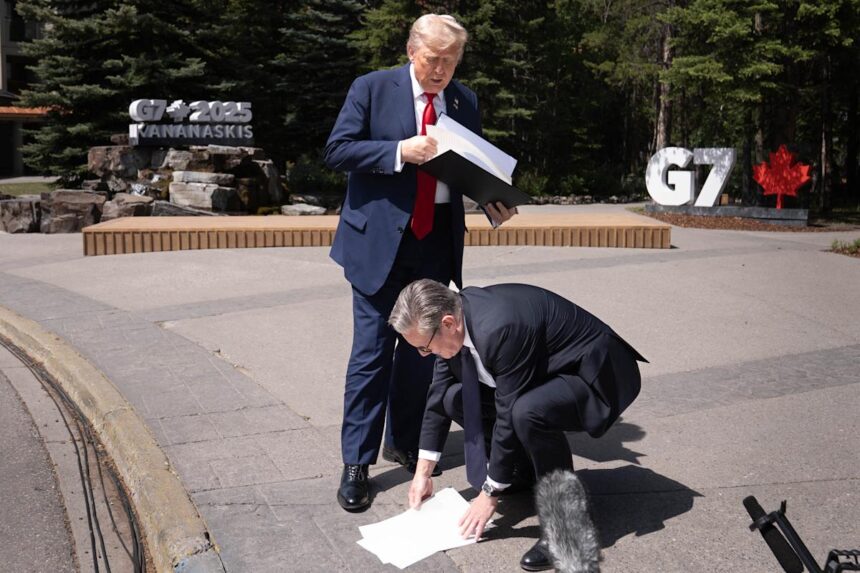The chatter in Brussels diplomatic circles has grown increasingly anxious this week as Canadian and European Union negotiators huddle for what might be their most consequential trade discussions in years. I’ve spent the past three days moving between policy briefings and off-record conversations with officials who speak with unusual frankness when the recording devices are put away.
“We’re essentially preparing for economic warfare,” confided a senior EU trade official yesterday evening over coffee near the Commission headquarters. “Not against Canada, of course, but we’re both looking at the same storm clouds on the horizon.”
Those storm clouds have a name: Donald Trump’s proposed blanket tariffs, which loom large over these talks. What began as routine trade maintenance discussions have transformed into something resembling a strategic alliance negotiation.
The Canadian delegation arrived with unusual urgency, led by Trade Minister Mary Ng, who canceled three domestic appearances to extend her Brussels stay. Walking alongside her team between buildings yesterday, I asked about their priorities. Rather than the typical diplomatic non-answer, Ng was surprisingly direct.
“We’re in a moment that requires new thinking about trade partnerships,” she told me. “Canada and Europe share values and economic philosophies that naturally align us in challenging times.”
What’s striking about these discussions is their scope. According to briefing documents obtained during my reporting, negotiators are exploring mechanisms that would allow for rapid supply chain restructuring if global trade conditions deteriorate. This includes contingency plans for critical minerals, pharmaceutical ingredients, and advanced manufacturing components.
The Economic Council of Canada estimates that Trump’s proposed universal 10% tariff would cost Canadian exporters approximately $22 billion annually, with sectors like automotive manufacturing and agricultural products bearing the heaviest impact. European Commission analysis projects similar proportional damage to EU economies, with Germany and France facing potential export losses exceeding €40 billion combined.
“We’re not just talking about tariff schedules anymore,” explained Dominique Riquet, Vice-Chair of the European Parliament’s International Trade Committee. “We’re discussing how to build resilient trade corridors that can withstand external pressure. This is about economic security now.”
The negotiations have revealed how quickly geopolitical realities can transform trade relationships. In conversations with delegates from both sides, three priorities have emerged consistently:
First, establishing alternative supply chains that reduce dependence on potentially volatile trading partners. Second, creating mechanisms for rapid regulatory alignment during crises. And third—perhaps most tellingly—developing coordinated response frameworks for retaliatory tariffs.
“Ten years ago, we would have considered such discussions unusual between friendly nations,” remarked a veteran Canadian trade negotiator who requested anonymity to speak freely. “Now they’re essential. We’re planning for resilience in a world where economic weapons are increasingly the first choice, not the last.”
Data from the International Monetary Fund supports this strategic pivot. Their recent Global Trade Uncertainty Index shows a 45% increase in trade policy unpredictability over the past 18 months, approaching levels last seen during the height of previous trade conflicts.
The human dimensions of these abstract policy discussions became evident during a stakeholder consultation I attended yesterday. Representatives from Quebec’s aluminum sector and Belgium’s specialty manufacturing associations shared remarkably similar concerns about community impacts.
“We’ve survived previous tariff rounds, but barely,” said Marcel Tremblay, who leads a consortium of Quebec metal exporters. “Some of our member companies never recovered from the last round. We’re talking about multigenerational businesses and entire towns built around these industries.”
His European counterparts nodded in solemn agreement. The previous steel and aluminum tariffs led to the closure of 17 mid-sized manufacturing facilities across Europe, according to European Steel Association figures.
What makes these talks particularly consequential is their timing. Sources close to the negotiations confirm that both sides are working against an internal deadline that aligns with the U.S. election calendar—specifically, they aim to have framework agreements in place before November.
The legal frameworks being explored include provisions that would allow for accelerated regulatory equivalence determinations—essentially creating fast-track approvals for products meeting either Canadian or EU standards during trade disruptions. This would enable quicker supply chain pivots if other markets become less accessible.
Beyond the technical details, there’s a philosophical alignment that appears to be driving these talks forward with unusual speed. Both delegations repeatedly reference their shared commitment to rules-based international trade at a time when such systems face unprecedented challenges.
“We’re not just preserving Canada-EU trade,” said EU Trade Commissioner Valdis Dombrovskis during a brief media availability. “We’re demonstrating that predictable, rules-based trading relationships remain viable and valuable, especially during uncertain times.”
The Supreme Court’s recent decision not to expedite legal challenges to potential tariffs has only added urgency to these discussions. Both Canadian and European negotiators mentioned this development in our conversations, seeing it as removing a potential constraint on aggressive trade actions.
As these talks continue through the week, their significance extends far beyond the technical details of tariff schedules and regulatory harmonization. They represent something more fundamental: an attempt to reshape trade relationships for an era where economic nationalism increasingly challenges global integration.
For communities whose livelihoods depend on export industries—from Quebec’s aluminum towns to specialty manufacturers across Europe—the stakes couldn’t be higher. Their futures may well depend on whether these negotiators can build trade structures resilient enough to withstand the economic storms gathering on the horizon.






